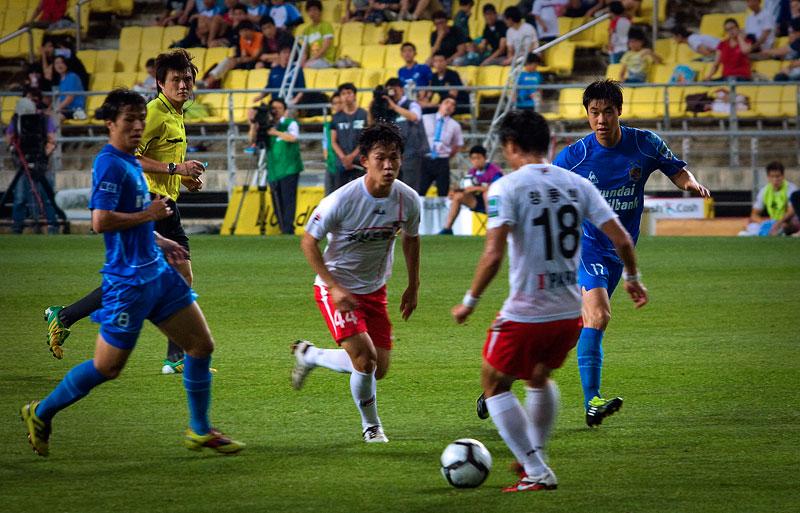It has been a long time since I shot sports and a few weeks ago I swung by Munsu Stadium for the last half hour of the K-league finals in Ulsan. I must admit that I was a little rusty but I still enjoyed the action. I was never really a huge fan of soccer until I had the opportunity to shoot for the AFC Champions league from 2006 to 2007. Learning the in’s and out’s of sports photography on the fly really taught me a lot about the industry and the business. I will dispense this knowledge now, but please understand that I am nowhere near a seasoned vet, I just know what I know…
1. Don’t be afraid to call
If you ever wonder how to get press passes to shoot events, look no further than your phone or the internet. Many times there is a certain time frame for which to apply to get a press pass. For some more international events, they will only give out passes to actual print publications and whatnot, but many of the local K-league events may let you in. I know in Ulsan, the club is quite friendly and always willing to gain support from the expat community and photographers. Aside from the AFC stuff, I was also permitted into their headquarters for an interview when I was doing the Ulsan Pear. All it took was a phone call and some emails, if I remember correctly.
2. Get The Gear
If you are going to try and get quality results then your 300 mm f/5 zoom lens won’t really cut it. Sports photography is expensive the the gear that the pros use is not cheap. I am still searching for places that rent lenses in Korea and as soon as I find one, I will post it up. The best lens that I have is my trusty 70-200 f/2.8 and that barely covers the field. I also have the 2x extender to give it more reach but it has it’s drawbacks. With the extender on, you lose the f2.8 fastness as that too gets multiplied by 2.
Monopods are essential to this game and if you don’t have one and think that you can go a whole game hand-holding a big lens, you can’t. They are not as imposing as a full on tripod and a little cheaper too. A lot of the pros here in Korea have little camping stools with them. Personally, I have never used them but I can see why they would come in handy.
3. Know Where to Shoot
There are certain places where photographers are allowed to shoot. For soccer it is usually the corners of the field. If you are not sure where to shoot do some research or ask the other photographers. Be careful with this because paid photographers can get territorial and if you take somebody’s spot they may get more than a little angry. Also if you are in the wrong spot, you may have security breathing down your neck. It is best to search forums like Sports Shooter to get a better idea of what and where to shoot.
4. FACES, FACES, FACES
One of the biggest mistakes that people make is that they tend to capture the action over the face of the player. While the action maybe dramatic, it is the face that people relate to. When editors look for photos to run, typically they are looking for ones that have a lot of action but include the face. Psychologically, we are drawn to certain features of the human body and the eyes and face are among to most important. The years, that I was with the AFC, I noticed that most of the photos they selected were ones that had the faces in focus and usually some sort of emotion showing.
5. Get you safe shots first before experimenting
By “safe shots” I mean the standard shots that everyone wants. Shots of the goals, celebrations, coaches, star players with the ball, etc. Once you get those or at least a few of them you can experiment with different angles and whatnot. The last thing that you want is to have a bunch of shots that are good on their own but do not reflect the events of the game. Think of going to a birthday party and rather than getting the shots of the happy birthday person opening gifts and the friends having a good time, you got artistic shots of beer bottles and portraits that did not reflect the actual event. Standing a lone those shots would be great, but to reflect that birthday party they would not. So, get the safe shots that tell the story then go wild with the artistic side of you.
The only other real advice is to get to know the game. One of the biggest challenges for me was knowing the game of “soccer” or rather “football” as I have been instructed to call it. This means knowing the positions, plays, key players, and everything about the game. When I shot with some pros in Canada during a rally race, they new the races so well that they could look at the course, get to a location and set up and know that they are going to get the best shots.










Recent comments